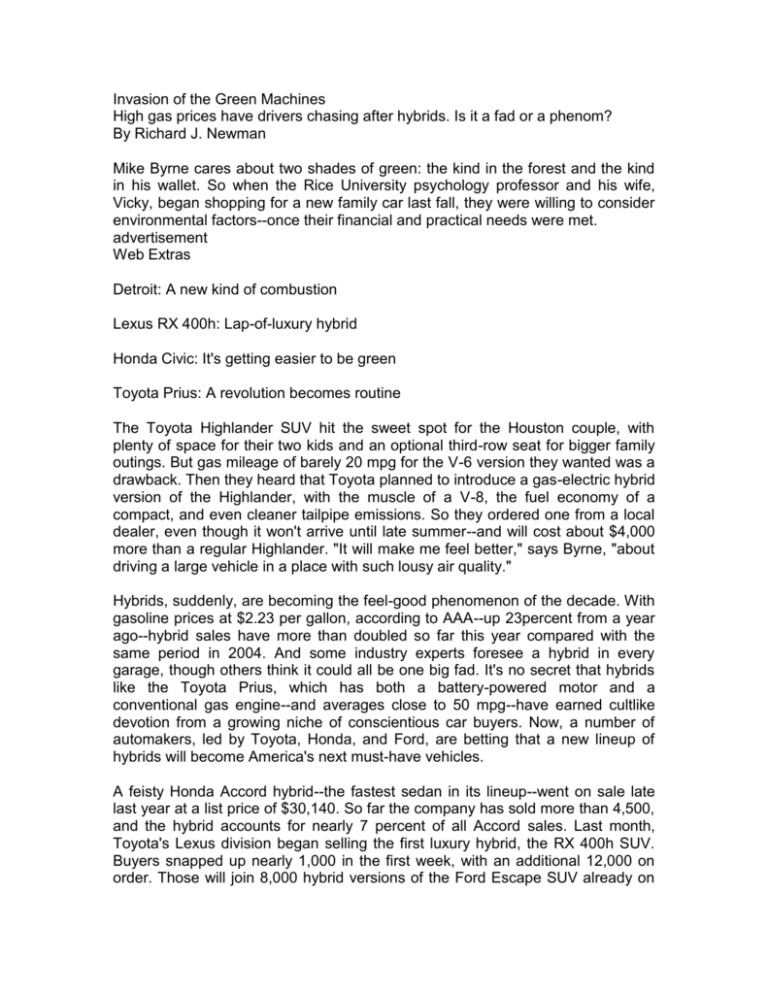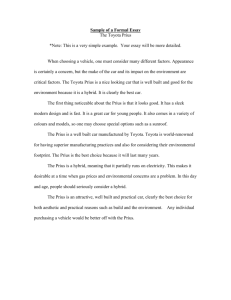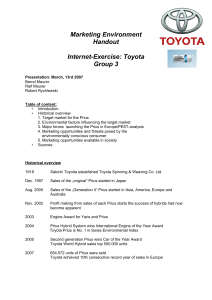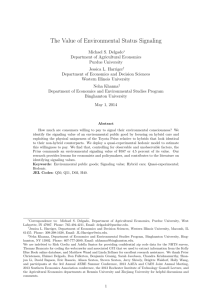
Invasion of the Green Machines
High gas prices have drivers chasing after hybrids. Is it a fad or a phenom?
By Richard J. Newman
Mike Byrne cares about two shades of green: the kind in the forest and the kind
in his wallet. So when the Rice University psychology professor and his wife,
Vicky, began shopping for a new family car last fall, they were willing to consider
environmental factors--once their financial and practical needs were met.
advertisement
Web Extras
Detroit: A new kind of combustion
Lexus RX 400h: Lap-of-luxury hybrid
Honda Civic: It's getting easier to be green
Toyota Prius: A revolution becomes routine
The Toyota Highlander SUV hit the sweet spot for the Houston couple, with
plenty of space for their two kids and an optional third-row seat for bigger family
outings. But gas mileage of barely 20 mpg for the V-6 version they wanted was a
drawback. Then they heard that Toyota planned to introduce a gas-electric hybrid
version of the Highlander, with the muscle of a V-8, the fuel economy of a
compact, and even cleaner tailpipe emissions. So they ordered one from a local
dealer, even though it won't arrive until late summer--and will cost about $4,000
more than a regular Highlander. "It will make me feel better," says Byrne, "about
driving a large vehicle in a place with such lousy air quality."
Hybrids, suddenly, are becoming the feel-good phenomenon of the decade. With
gasoline prices at $2.23 per gallon, according to AAA--up 23percent from a year
ago--hybrid sales have more than doubled so far this year compared with the
same period in 2004. And some industry experts foresee a hybrid in every
garage, though others think it could all be one big fad. It's no secret that hybrids
like the Toyota Prius, which has both a battery-powered motor and a
conventional gas engine--and averages close to 50 mpg--have earned cultlike
devotion from a growing niche of conscientious car buyers. Now, a number of
automakers, led by Toyota, Honda, and Ford, are betting that a new lineup of
hybrids will become America's next must-have vehicles.
A feisty Honda Accord hybrid--the fastest sedan in its lineup--went on sale late
last year at a list price of $30,140. So far the company has sold more than 4,500,
and the hybrid accounts for nearly 7 percent of all Accord sales. Last month,
Toyota's Lexus division began selling the first luxury hybrid, the RX 400h SUV.
Buyers snapped up nearly 1,000 in the first week, with an additional 12,000 on
order. Those will join 8,000 hybrid versions of the Ford Escape SUV already on
the road. All told, nearly 25 hybrids from a dozen carmakers are due in
showrooms by 2008. Overall, hybrid sales will top 200,000 this year, according to
J. D. Power & Associates, and some experts see nothing but open road ahead.
Within 20 years, predicts Jim Press, Toyota's top U.S. executive, "virtually
everything on the market is going to be a hybrid."
Japan takes the lead. If Press is right, Detroit could be in for an even worse
drubbing than the Japanese have administered over the past two decades. Since
1995, General Motors, Ford, and Chrysler have seen their share of the U.S.
market fall from 73 percent to about 58 percent, while Toyota, Nissan, and
Honda have raised their share from 18 percent to 28 percent. GM and Chrysler
will be at least seven years behind Toyota once their first full hybrids debut over
the next couple of years. Ford has earned plaudits for the hybrid Escape,
introduced last year, but it won't have a hybrid sedan until 2008.
Hybrids, in fact, are a key cog in Toyota's strategy to become the world's biggest
and most successful carmaker. In 2003, Toyota surpassed Ford to become the
world's second-largest auto manufacturer. And the company's ambition to grab
15 percent of the global auto market sometime after 2010 would put it in a
position to overtake GM, which has been No. 1 since 1931. "Ford and GM are
going to get smaller," says Mark Oline of Fitch Ratings. "Toyota will get bigger."
advertisement
Web Extras
Detroit: A new kind of combustion
Lexus RX 400h: Lap-of-luxury hybrid
Honda Civic: It's getting easier to be green
Toyota Prius: A revolution becomes routine
Detroit's sliding fortunes have routinely been blamed on insular thinking and a
disconnect with consumer tastes. Yet there's sound logic behind a go-slow
approach to hybrids. Higher gas mileage may mean fewer stops at the filling
station, but that doesn't mean hybrids necessarily save money. The battery pack,
extra motor, and other technology that come with a hybrid typically add $3,000 to
$4,000 to the base price of the car. Even with gas at more than $2 per gallon,
fuel savings may not pay for the premium. According to a savings calculator on
Honda's website, for instance, the Accord hybrid, if driven 12,000 miles per year,
would net just $1,595 in savings over a decade, compared with a regular V-6
Accord. Byrne figures that at the rate he drives, it will take seven years for the
mileage savings to offset the higher price of the Highlander hybrid. That's a year
longer than the average American keeps a new car, according to R. L. Polk & Co.
Other savings come from a $2,000 federal tax deduction--which President Bush
last week proposed raising to $4,000--and state or local incentives.
Still, to many automotive engineers, that kind of math makes the case against
hybrids--not for them. They find it perplexing that consumers would pay extra for
a feature that adds little to the driving experience and takes so long to pay for
itself. And while hybrids get their best mileage in stop-and-go traffic, where the
electric motor is doing a lot of the work, the mileage boost is modest on the
highway or in the kind of suburban driving many Americans do. "There are
applications where it's great and applications where it's not so great," says Dieter
Zetsche, chief executive of the Chrysler Group. Failing to quickly recognize the
emotional appeal of the technology, he says, is one reason Chrysler doesn't yet
have a full hybrid.
Like sports cars and convertibles, hybrids have become popular for reasons that
have little to do with practicality. The only noticeable difference on the road is the
golf-cart effect: The gas engine shuts down at stops to save gas, then starts up
automatically when you press the accelerator. But hybrids also come with
dashboard power meters and other funky instrumentation meant to appeal to
tech hounds and make the cars seem cutting edge. When Ramsey Brous of
Ithaca, N.Y., bought an Accord hybrid last December, he knew that he'd be
paying extra to be an "early adopter" of the technology. That was fine with the
38-year-old bakery owner, who's more interested in helping push the
development of hybrids than saving a few bucks. "I'm willing to be a guinea pig to
get the car industry to pay attention to mpg," he says. Like many other hybrid
fanatics, he religiously tracks his mileage in a notebook he keeps on the console
between the front seats. His only complaint, ironically, has been . . . low mileage.
Brous's Accord has averaged less than 24 mpg, about 30 percent below
advertised figures. He blames the cold--a frequent complaint of hybrid owners in
northern climates--and says his mileage has risen along with the temperatures.
While other automakers were dismissing the math, Honda, Toyota, and Ford
sensed an appeal beyond dollars and cents. "There's a very emotional
component there," says Jon Lancaster, who owns Toyota and Lexus dealerships
in Madison, Wis., and sells 20 Priuses per month. With growing concern about
U.S. dependence on foreign oil, he says, "it makes you feel like you can do
something about it." When Toyota's engineers first began sketching the Prius,
part of their goal was to improve the fuel economy of Toyota's overall fleet. But
Toyota also hoped that mass-producing one of the world's most efficient cars
would buff its image as a high-tech and environmental innovator.
Toyota Prius: A revolution becomes routine
Celebrity fare. For that, it has been willing to pay. Most analysts believe that the
company has subsidized the Prius, eating some of the cost of the hybrid system
instead of passing it on to consumers. Toyota also has gotten some unexpected
help. Unsolicited endorsements from celebrities like Leonardo DiCaprio and
surging gas prices have transformed the Prius from an oddball experiment into
an object of desire. Toyota sold 50,000 in 2004, after the redesigned secondgeneration Prius went on sale, and still had waiting lists. This year the company
plans to sell 100,000. "They made a good play," says Larry Burns, head of
research and development for General Motors. "Toyota did get ahead of the
domestics."
The early lead has made Toyota the default option for many hybrid enthusiasts.
When Cindy Petzold, who lives outside Madison, decided to buy a hybrid last fall,
the Prius seemed like the only choice--even though she'd have to wait four
months for it. "Toyota has been at it the longest," says the hospital lab technician,
who calls herself a "recycling Nazi." Like many other hybrid owners, she hopes
that driving a Prius signals she's doing her part.
The question now is whether the hybrid movement will gain momentum or run
out of gas. So far, hybrid buyers have been wealthier and better educated than
car shoppers overall. Automakers see that as an opportunity to market hybrid
power trains as a premium feature, like a navigation system or leather interior,
that well-wheeled consumers are likely to pay extra for. One reason Honda
decided to load up the Accord hybrid and price it near the top of its lineup is that
regular Accord owners were trading in their midpriced sedans for the lessexpensive hybrid version of the Civic. That violated a basic rule of auto
salesmanship: Get your existing customers to trade up, not down. It also told
Honda that hybrids and their image of social responsibility might be a fresh way
to land desirable customers. "We want to attract new, affluent buyers to the
Accord," says Dan Bonawitz, Honda's marketing chief.
At some point, however, hybrids need to pay their own freight if they are to
become more than a trendy way for drivers and automakers to feel better about
themselves. Hybrid manufacturers hope that early adopters will help drive sales
volumes high enough for the cost of the new technology to be spread across
more vehicles, lowering average prices.
Moon roof. But J. D. Power forecasts that hybrid fever will cool off once the dualpowered vehicles hit about 3 percent of the market, probably around 2011.
Pragmatic mainstream buyers may prefer to spend extra money on performance
and comfort options instead of a feel-good power train. David Backman of
Minneapolis looked at a Prius when he was shopping for a new car last year. But
the computer specialist settled instead on a Hyundai Elantra GT. The mileage
isn't as good, but he was able to load it up with a moon roof, leather interior, and
other goodies, all for $9,000 less than the Prius. "At 10,000 miles a year," he
concludes, "I would never come close to recouping the premium."
GM's Burns sees other limitations of hybrids--under the Prius's hood. When
Toyota introduced the second-generation Prius last year, GM joined the mad
dash of consumers rushing out to buy one. But not to drive. Instead, GM
engineers disassembled the car at the company's Vehicle Assessment Center in
Warren, Mich., and laid the guts of the propulsion sys-tem out on a long shelf.
One major discovery: The Prius's hybrid power train contains 42 percent more
parts than the machinery that moves a similar-size Chevrolet Malibu. That,
argues Burns, is too much complexity for the car of the future.
A new kind of gas. Instead of cars with two motors and space-hogging batteries,
he says, the automakers who rule the roads in the 21st century need to invent
sophisticated but simpler cars that are cheaper to build. That's one reason that
GM, like DaimlerChrysler and other automakers, is putting its chips on hydrogenpowered cars.
But the auto giant has a history of misjudging the market. Around the time Toyota
was designing the first Prius, GM was rolling out the EV1, a battery-powered
electric car that debuted, with much fanfare, in 1996. For less than the cost of a
tank of gas, the car's batteries could be recharged at home, overnight, which led
GM to tout the oblong two-seater as the car of the future. But progress in battery
technology stalled, and the range never eclipsed 150 miles, which severely
limited its appeal. Last year, GM decided to cut its losses on the $1 billion project
and retired the last of the 1,000 cars that had been leased to consumers. An EV1
is now headed to the Smithsonian.
Hybrids are a more urgent matter. GM and DaimlerChrysler recently joined
forces on a crash R&D program, and both companies plan to introduce their first
full hybrids in 2007. GM in particular could leapfrog its rivals by introducing fullhybrid versions of products that are still market heavyweights, like the Chevy
Silverado pickup truck and the TrailBlazer SUV. Meanwhile, other automakers
that have confidently dismissed hybrids as a fad are suddenly racing to catch up
with Toyota and Honda. Cash-rich Nissan has purchased Toyota's technology
and is rushing a system to market. Ford subsidiary Mazda plans a hybrid version
of the Tribute SUV. Even BMW promises a hybrid announcement later this year.
Most drivers may never track their mileage in a notebook, yet there may be no
way of escaping cars with a conscience.
Copyright © 2005 U.S.News & World Report, L.P. All rights reserved.








